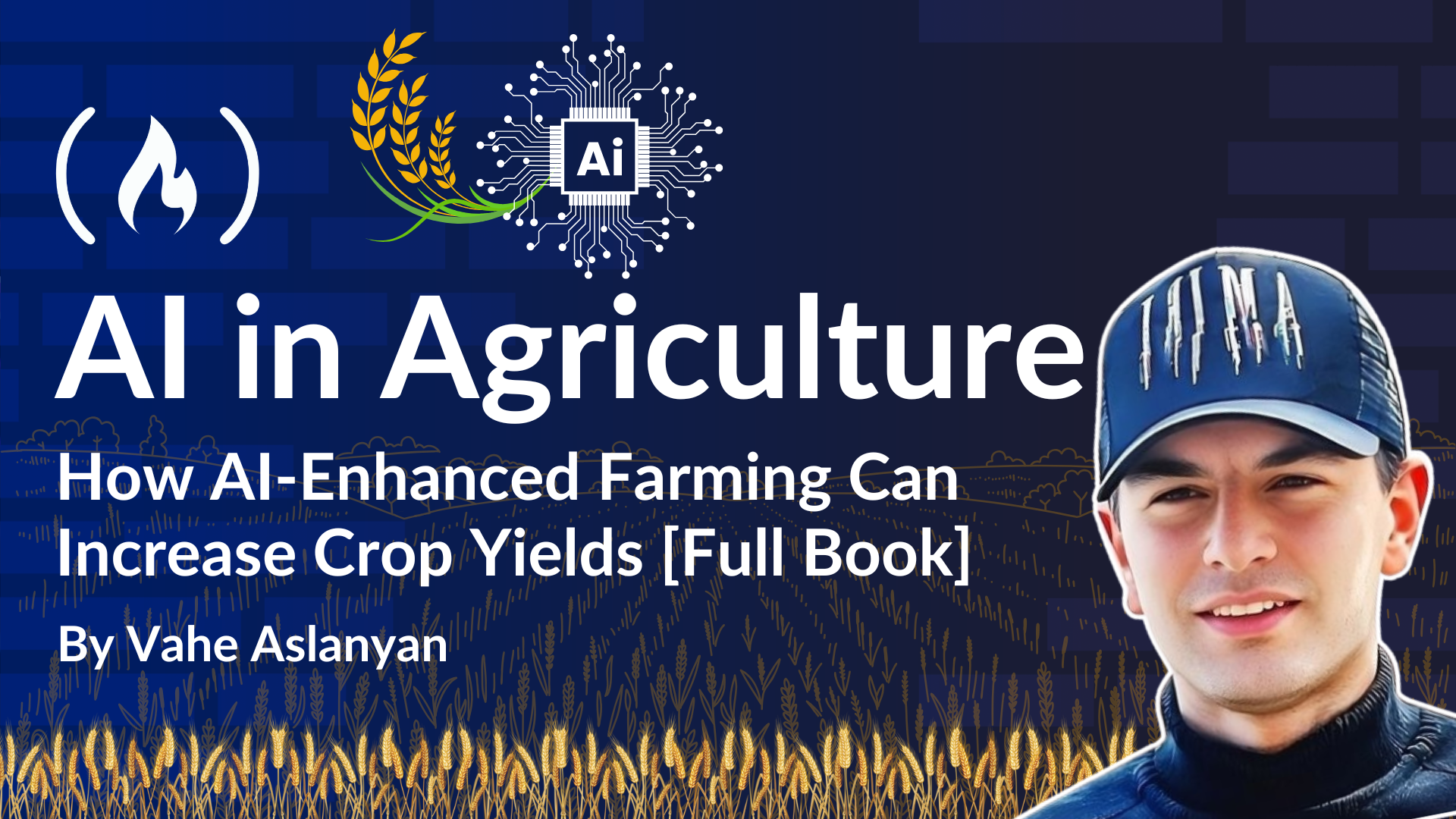
The Role of AI in Transforming Agriculture
The Role of AI in Transforming Agriculture 관련
In recent years, the integration of artificial intelligence with agriculture has dramatically transformed traditional farming techniques, heralding a new era of productivity and sustainability.
This chapter examines the profound impact of AI on agriculture, offering an all-encompassing perspective on how AI can revolutionize farming practices, optimize crop yields, and promote environmental sustainability.
Precision Agriculture through AI
Precision agriculture stands as a flagship application of AI within the agricultural domain. By allowing farmers to make highly informed decisions derived from granular data, AI elevates farming practices to unprecedented levels of efficiency and precision.
AI-driven systems analyze multifaceted data inputs, such as soil conditions, weather patterns, and crop performance metrics, creating a cohesive picture that empowers farmers to optimize every facet of crop management.
Rather than relying on broad-spectrum agricultural practices, precision agriculture tailors interventions to the unique needs of individual fields and even specific zones within those fields.
This hyper-local management not only maximizes crop yields but also curbs resource wastage, ultimately leading to a more sustainable and profitable farming operation. These data-driven decisions extend to optimal planting times, irrigation schedules, and fertilization plans, crafting an intricate roadmap to agricultural success.
In this example, we'll simulate how AI can help in precision agriculture by collecting soil data, weather data, and crop performance metrics. A model will be used to suggest optimal irrigation schedules and fertilization plans based on this data.
import numpy as np
from sklearn.ensemble import RandomForestRegressor
# Sample data for soil moisture, temperature, and crop performance
soil_moisture = np.array([30, 35, 32, 45, 40]) # percentage
temperature = np.array([18, 21, 19, 23, 22]) # Celsius
crop_yield = np.array([80, 85, 83, 90, 88]) # yield per hectare
# Labels for optimal irrigation and fertilization in percentage
irrigation = np.array([20, 25, 22, 30, 28]) # water in percentage
fertilizer = np.array([5, 6, 5, 7, 6]) # fertilizer in kg/ha
# Train a model for irrigation schedule
irrigation_model = RandomForestRegressor()
irrigation_model.fit(np.column_stack((soil_moisture, temperature, crop_yield)), irrigation)
# Train a model for fertilizer schedule
fertilizer_model = RandomForestRegressor()
fertilizer_model.fit(np.column_stack((soil_moisture, temperature, crop_yield)), fertilizer)
# Simulating new data for a prediction
new_soil_moisture = 38
new_temperature = 20
new_crop_yield = 85
predicted_irrigation = irrigation_model.predict([[new_soil_moisture, new_temperature, new_crop_yield]])
predicted_fertilizer = fertilizer_model.predict([[new_soil_moisture, new_temperature, new_crop_yield]])
print(f"Predicted irrigation schedule: {predicted_irrigation[0]:.2f}% water")
print(f"Predicted fertilizer plan: {predicted_fertilizer[0]:.2f} kg/ha")
Machine Learning: Pioneering Predictive Crop Management
In the realm of modern agriculture, machine learning algorithms have emerged as indispensable assets. These algorithms digest vast, complex datasets encompassing soil moisture levels, plant health monitoring indicators, and meteorological forecasts, to develop predictive analytics models.
These models empower farmers to anticipate crop outcomes, facilitating proactive interventions designed to mitigate potential risks and bolster productivity.
For instance, by forecasting potential pest infestations or disease outbreaks, farmers can implement timely preventive measures, safeguarding crop health and ensuring optimal yield. This predictive capability extends beyond immediate crop management, aiding in long-term planning for resource allocation and operational logistics. The integration of machine learning not only enhances current farming practices but also fortifies the agricultural sector against future challenges.
In this code snippet, a machine learning model predicts the likelihood of a pest infestation based on factors like soil moisture and weather conditions.
from sklearn.linear_model import LogisticRegression
# Sample data (soil moisture, temperature, pest infestation - 0 means no infestation, 1 means infestation)
data = np.array([[30, 22, 0], [35, 25, 0], [40, 28, 1], [25, 20, 0], [45, 30, 1]])
X = data[:, :2] # Soil moisture, temperature
y = data[:, 2] # Pest infestation
# Train a Logistic Regression model
pest_model = LogisticRegression()
pest_model.fit(X, y)
# Predicting on new data
new_soil_moisture = 33
new_temperature = 27
predicted_pest_risk = pest_model.predict([[new_soil_moisture, new_temperature]])
predicted_prob = pest_model.predict_proba([[new_soil_moisture, new_temperature]])[0][1]
if predicted_pest_risk[0] == 1:
print(f"High risk of pest infestation! Probability: {predicted_prob:.2f}")
else:
print(f"Low risk of pest infestation. Probability: {predicted_prob:.2f}")
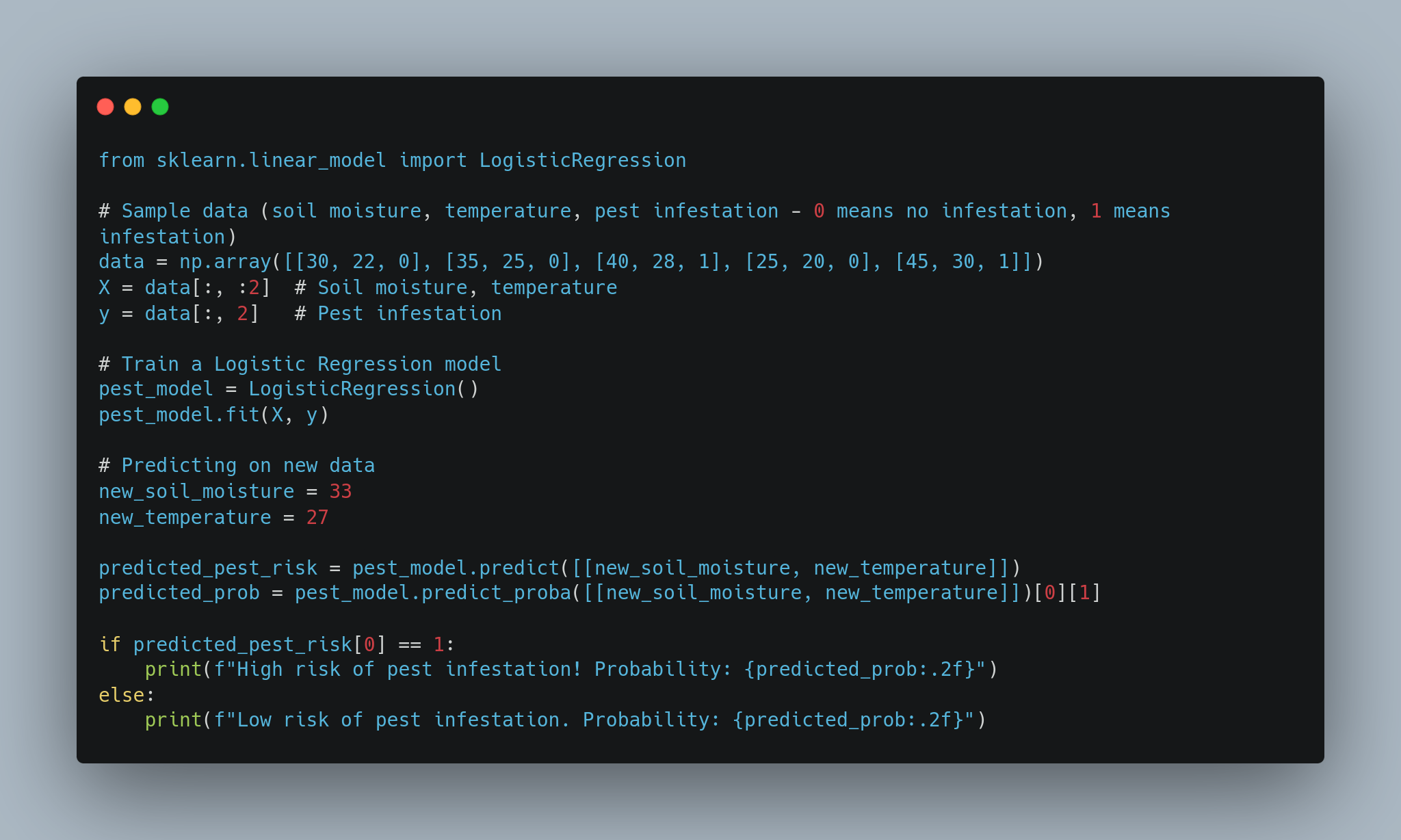
Farm Operations Transformed by Computer Vision
Computer vision technology propels agriculture into a new frontier, where machines possess the ability to "see" and interpret visual data with astounding accuracy. Employing sophisticated cameras and sensors, computer vision systems meticulously monitor crop health, detect and identify pest infestations, and evaluate soil quality in real-time.
The precision of computer vision enables the early detection of subtle changes in crop health that might elude the human eye. By identifying stressors such as nutrient deficiencies or water stress early, farmers can initiate targeted interventions, promoting healthier crops and improved yields.
This technology not only ensures timely management but also reduces the reliance on chemical treatments, fostering a more sustainable approach to pest and disease control.
Here, we simulate a simple computer vision task to detect unhealthy crops using image data, where red areas in the crop image might indicate stress or disease.
import cv2
import numpy as np
# Simulate a crop image with random red patches (signifying stress)
image = np.zeros((100, 100, 3), dtype="uint8")
cv2.rectangle(image, (30, 30), (70, 70), (0, 0, 255), -1) # Simulating stress area
# Convert to HSV to detect red areas
hsv_image = cv2.cvtColor(image, cv2.COLOR_BGR2HSV)
lower_red = np.array([0, 120, 70])
upper_red = np.array([10, 255, 255])
mask = cv2.inRange(hsv_image, lower_red, upper_red)
# Calculate percentage of red (stressed) area
red_area_percentage = np.sum(mask > 0) / (image.shape[0] * image.shape[1]) * 100
if red_area_percentage > 10:
print(f"Alert! {red_area_percentage:.2f}% of the crop area shows signs of stress.")
else:
print(f"Healthy crops. Only {red_area_percentage:.2f}% of the area shows stress.")
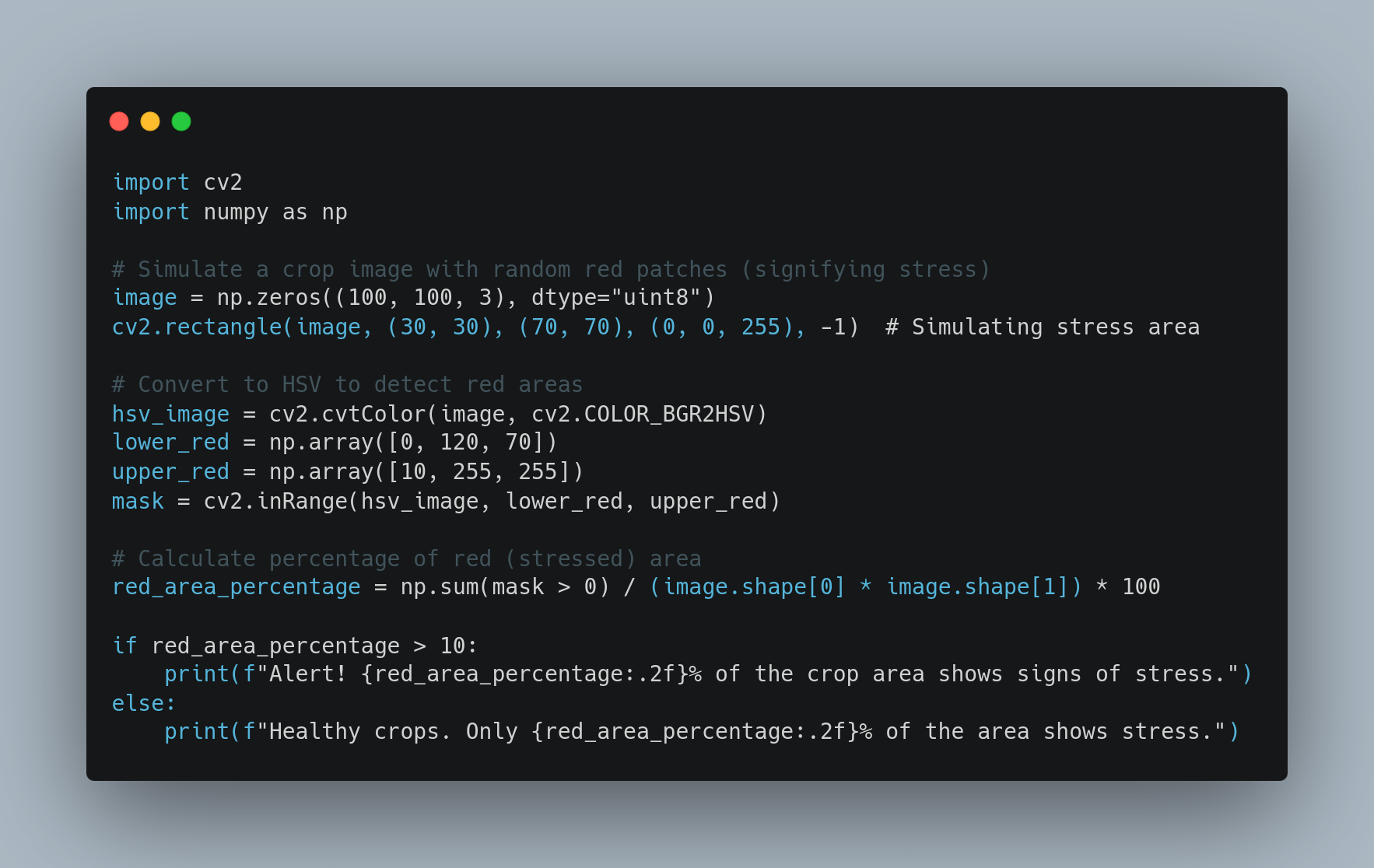
AI-Driven Sustainability in Agriculture
One of the most compelling promises of AI in agriculture lies in its potential to drive sustainability. Through optimized land use and resource management, AI models contribute to reducing the environmental footprint of farming activities. AI algorithms can recommend precise dosages of water, fertilizers, and pesticides, minimizing overuse and runoff that can harm surrounding ecosystems.
AI's ability to analyze and predict climate patterns also supports the development of resilient agricultural practices. By helping farmers adapt to changing weather conditions and extreme events, AI fosters a more stable and sustainable food production system. This aspect is particularly crucial in the face of global climate change and the increasing demand for food from a growing population.
In this example, AI recommends optimal resource usage (water and fertilizer) based on predicted environmental data to minimize resource waste.
# Environmental and crop data
rainfall_forecast = 50 # mm
soil_type = 'clay' # clay, sand, silt
crop_stage = 'vegetative' # stages: seedling, vegetative, reproductive
def recommend_water(rainfall, soil, stage):
base_water = 20 # base liters per hectare
if soil == 'sand':
base_water += 5
if stage == 'reproductive':
base_water += 10
if rainfall > 30:
base_water -= 5 # reduce water if heavy rain predicted
return max(base_water, 5)
def recommend_fertilizer(stage):
if stage == 'seedling':
return 3 # kg/ha
elif stage == 'vegetative':
return 6
else:
return 10
# Predictions for optimal resources
optimal_water = recommend_water(rainfall_forecast, soil_type, crop_stage)
optimal_fertilizer = recommend_fertilizer(crop_stage)
print(f"Optimal water usage: {optimal_water:.2f} liters per hectare")
print(f"Optimal fertilizer dosage: {optimal_fertilizer:.2f} kg/ha")
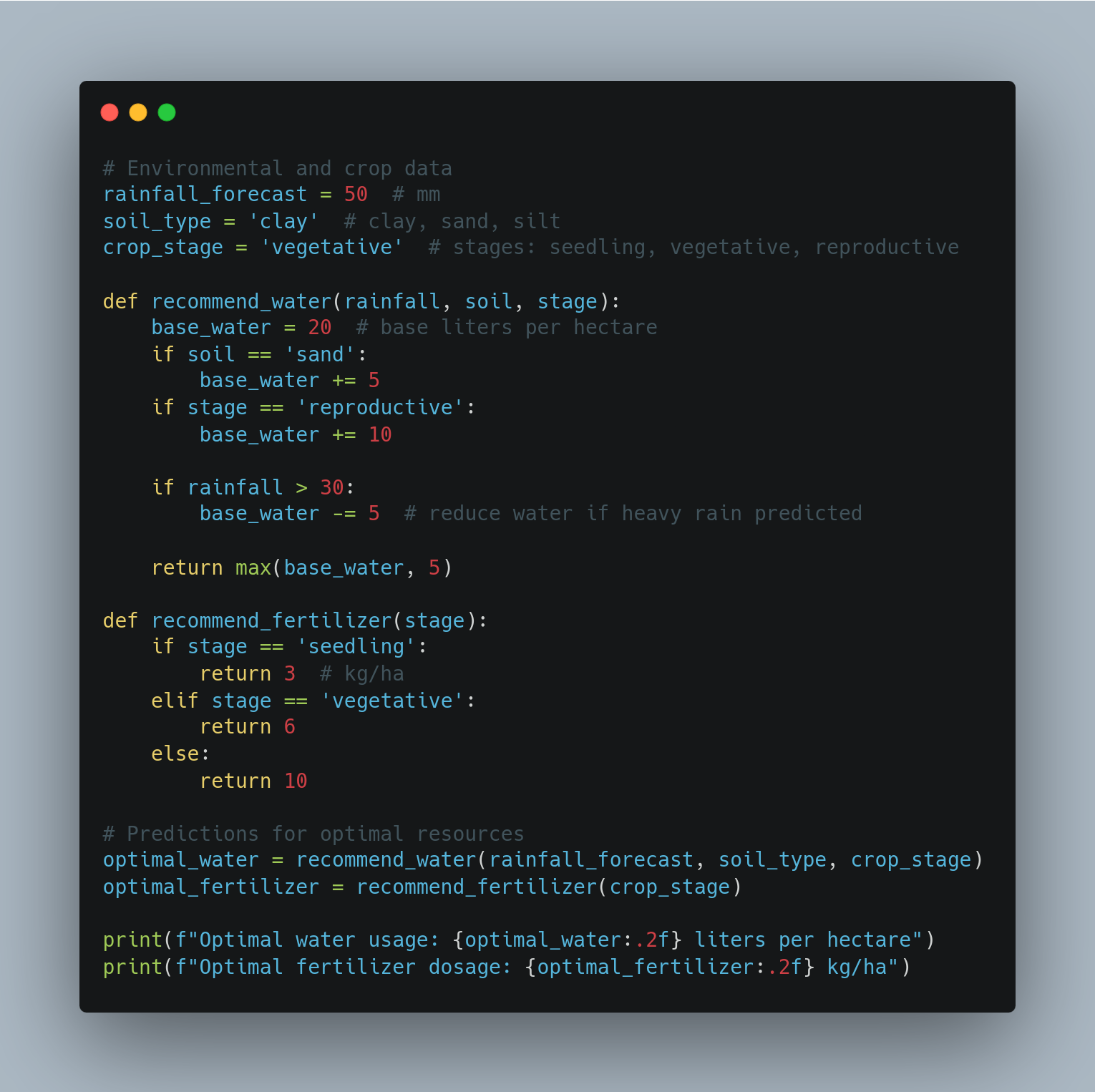
Addressing Future Agricultural Challenges with AI
The agricultural sector stands at a crossroads, confronted by an array of challenges including labor shortages, extreme weather events, and the imperative for enhanced decision-making tools.
AI-powered solutions present a beacon of hope, offering tools and methodologies to navigate these obstacles effectively. By automating labor-intensive tasks such as planting and harvesting, AI eases the burden on the agricultural workforce.
Beyond this, AI's analytical capabilities provide farmers with the insights needed to adapt to evolving environmental and market conditions. Enhanced resilience is key, as the ability to swiftly respond to unforeseen challenges ensures the continuity of agricultural production and security of food supplies.
The transformation is not limited to technological or productivity aspects alone. AI also cultivates a mindset of continuous improvement and learning within the agricultural community. By embracing data-centric approaches and fostering an environment of innovation, AI nurtures a new generation of farmers equipped to tackle the intricacies of modern agriculture.
This example demonstrates how AI can assist in automating tasks like identifying ripened crops for automated harvesting using basic image processing.
import cv2
# Simulate crop image with different shades (representing ripened and unripened crops)
image = np.zeros((100, 100, 3), dtype="uint8")
cv2.circle(image, (30, 30), 20, (0, 255, 0), -1) # Green (unripe crop)
cv2.circle(image, (70, 70), 20, (0, 0, 255), -1) # Red (ripe crop)
# Convert image to HSV to detect red (ripened crops)
hsv_image = cv2.cvtColor(image, cv2.COLOR_BGR2HSV)
lower_red = np.array([0, 120, 70])
upper_red = np.array([10, 255, 255])
mask = cv2.inRange(hsv_image, lower_red, upper_red)
# Identify ripe crops for harvesting
ripe_area_percentage = np.sum(mask > 0) / (image.shape[0] * image.shape[1]) * 100
if ripe_area_percentage > 10:
print(f"Ripe crops detected! {ripe_area_percentage:.2f}% of the area is ready for harvest.")
else:
print(f"Insufficient ripeness. {ripe_area_percentage:.2f}% of the area is ready for harvest.")
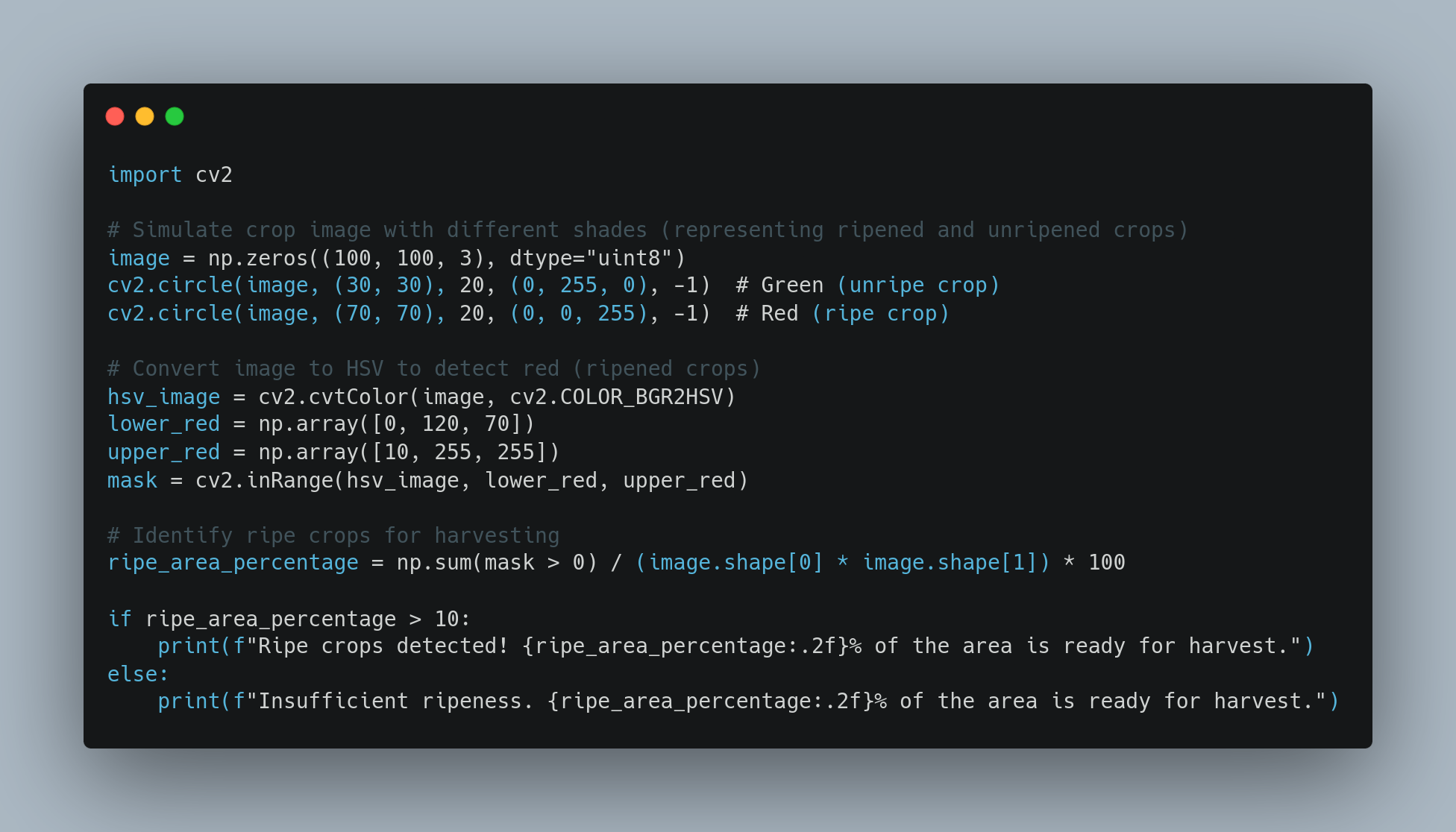
As you can now start to see, the integration of AI in agriculture is shaping the future of farming by moving beyond traditional methods and unlocking a plethora of possibilities for enhanced crop management, sustainability, and resilience.
By leveraging precision agriculture, machine learning, computer vision, and sustainability-focused AI models, the agricultural sector is poised to meet future challenges head-on, ensuring food security and environmental stewardship for generations to come.
The cumulative impact of these advanced technologies holds the potential to increase crop yields significantly, setting a path toward a more productive and sustainable agricultural industry by 2030 and beyond.